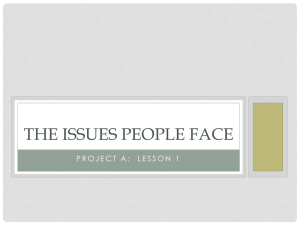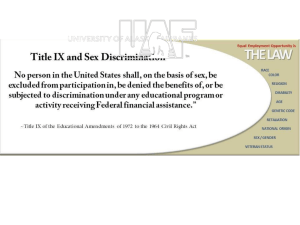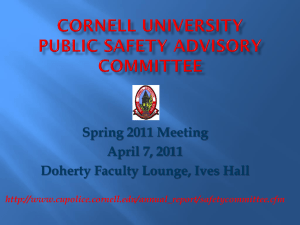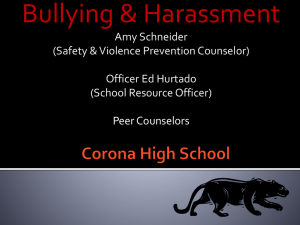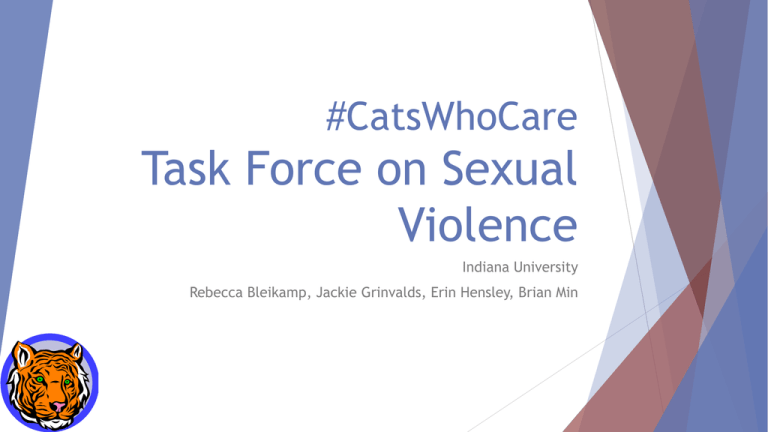
#CatsWhoCare
Task Force on Sexual
Violence
Indiana University
Rebecca Bleikamp, Jackie Grinvalds, Erin Hensley, Brian Min
Presentation Outline
Introduction
Application of Theory to Practice
Analysis of Problem, Stakeholders, Guiding Framework, Relevant Theories
Societal, Community, Relationship, Individual
Final Considerations
Limitations, Concluding Thoughts
Introduction
Analysis of Problem, Stakeholders, Guiding Framework, Relevant Theories
Analysis of Problem
As members of the Task Force on Sexual Violence, we are charged with
addressing sexual violence on our campus.
We believe that:
Sexual violence prevention is an important issue for all members of our campus.
Programs and procedures must address both individual and campus needs.
We, as student affairs professionals, share a responsibility with campus partners to
develop ethically responsible citizens of the students with whom we work.
Current cultural climate around the topic of sexual violence involves the
added complexity of legal context.
Stakeholders
Students and the organizations to which they belong
Current – Student Organizations including Greek
Chapters, Student Government, and Athletics
Prospective
Alumni
Faculty
Administration and Staff
Residents of the community
Government officials
Guiding Framework
In order to develop and implement effective programmatic efforts, we are using
the Dahlberg and Krug’s Social-Ecological Model (2002) to provide a framework
for creating a multi-dimensional and proactive approach.
This model addresses prevention
strategies and considers complex
interplay between the levels of
societal, community, relationship
and individual factors (A socialecological model, 2013).
The goals of each level expand from
changing attitudes and beliefs to
altering policies and social norms.
Individual
Relationship
Community
Societal
Relevant Theories
We consider it vital to incorporate student development theory in our plan to
effectively foster a culture of care at the institution. Relevant theories include:
Baxter Magolda’s Theory of Self-Authorship (2001)
Once engaged in dissonance, students’ meaning making process develops from
using external formulas through crossroads toward self-authorship
Occurs on the dimensions of cognitive, interpersonal, and intrapersonal
Kohlberg’s Stages of Moral Reasoning (1976)
As students develop, they move from their individually focused perspective toward
a morality in which they understand their role as a part of society
Gilligan’s Theory of Women’s Moral Development (1977)
Women’s experiences in moral development tend to differ from men and must shift
in understanding selfishness and responsibility
(Evans, Forney, Guido, Patton,
& Renn, 2010)
Application of Theory to Practice
Societal, Community, Relationship, Individual
Individual
Relationship
Community
Societal
Societal Level
Actions
Create committee of student representatives, law faculty members, student
affairs professionals, sexual violence experts, and others to collaborate with
diverse perspectives. They will:
Research peer institutions’ and share our policies and procedures to learn about
good practices from one another.
Review policies and procedures at our institution and compare them to the federal
guidelines to ensure not only compliance but that we are accommodating the
needs of both survivors and those accused of sexual violence. Include the following
factors as outlined in Dear Colleague letter:
Notice of nondiscrimination
Title IX Coordinator
Grievance Procedures
Societal
Societal Level
Rationale
At the societal level, factors that create a climate in which violence is
encouraged or inhibited include:
Social and cultural norms
Health, economic, educational, and social policies (A social-ecological model,
2013)
Reviewing policies and procedures that are directly related to sexual violence
on our campus will help address issues with the current culture that permits
sexual violence.
Societal
Community Level
Actions
To foster a caring community within our institution, we plan to implement
initiatives during first year and transfer orientation to promote a caring culture.
Introduce a culture that values care about one another. We will:
Inform students about the policies and reporting procedures regarding sexual
violence to ensure they feel supported.
Using technology, we will engage with alumni and work with student leaders from
various realms of influence to create videos in their environments to talk about
how they enact the values (i.e., student athletes filmed in their athletic facility).
Educate about and provide available resources.
Ask students to save SafeRide phone number into cell phone.
Introduce Circle of 6 cell phone application
Community
Community Level
Rationale
Baxter Magolda’s Theory of Self-Authorship (2001)
For those students entering the university with a dependence on
external formulas for meaning-making, seeing their peers emulate
the positive values will help familiarize them with the ethics of
care
Begin with policy to cognitively drive the other dimensions of
intrapersonal and interpersonal development and ultimately
promote care and non-violence in their interpersonal relationships
Community
(Evans et al., 2010)
Relationship Level
Actions
It is our responsibility to help students gain leadership skills that they will use
beyond their collegiate years and in their professional and personal lives.
Therefore, we would like to create a leadership development program that
would incorporate aspects of sexual violence education and responder training.
Create voluntary and engaging training for students who want to improve their
leadership skills and capabilities. Include:
Skills in leadership, communication, teambuilding, and problem solving
Include sexual assault components
Responder training – how student leaders could respond if a member of their organization
or community confided in them about situations involving sexual violence
Bystander intervention
Provide opportunities for further engagement, including training to become
peer educators or getting involved in community organizations
Relationship
Relationship Level
Actions
(continued)
Berkowitz (YEAR) claims that when it comes to sexual violence education,
efforts are more effective when they are geared towards single genders in
order to create a safe space for discussion (Gidycz, Orchowski, & Berkowitz,
2011) . We suggest programs include:
Women’s programming will include
Men’s programming using Gidycz et
topics such as:
al. (2011) programming
framework, covering topics of:
Feminism
Masculinities
Body Issues
Consent
Risk Reduction
Alcohol
What happens in reporting process
Dating
How to support a friend
Perpetuating Rape Culture
Relationship
Relationship Level
Rationale
Baxter Magolda’s Theory of Self-Authorship (2001)
Encourage students’ self-reflection regarding sexual violence
Promote discussions around the topic with peers to offer better understanding and
support
Gilligan’s Theory of Women’s Moral Development (1977)
Initiatives are group based to best serve female students and their need for
relationships with others
Conflict between self and other will be addressed through support groups for
women and discussions centered around the topic
Relationship
(Evans et al., 2010)
Individual Level
Actions
With the increasing use of social media by our students, we need to make efforts
to reach out to them via this method. We plan to:
Promote a culture of care through use of the hashtag #CatsWhoCare
Ask students to share pictures and experiences on Instagram and Twitter of
them enacting the values. Provides opportunity for students to:
Create messages wherever they feel comfortable and in their own space.
Think about what it means to be a student at this university and how their values
align with community values.
Collaborate with the alumni association to promote hashtag use by alumni to
engage and connect them with the current campus culture
Individual
Individual Level
Rationale
Prevention strategies at the individual level must promote attitudes, beliefs,
and behaviors that prevent violence (A social-ecological model, 2013).
Kohlberg’s Stages of Moral Reasoning (1976)
Encourage students, both past and present, to critically think about their values
and beliefs and how they make moral decisions regarding sexual assault
Process can oftentimes be difficult, so individual efforts may make it easier for
students to engage
Individual focus is first level within the model—hopefully prompts students to
transition to further stages
Individual
(Evans et al., 2010)
Final Considerations
Limitations, Concluding Thoughts
Limitations
We attempt to use a holistic view of not only individual students, but the
whole community; however, in the beginning staged, we have focused
primarily on students.
We considered relatively low-cost solutions to promote the culture of
#CatsWhoCare. However, the efforts take time and resources from members
of the institution.
We based our solution on a single campus and included some peer
institutional collaboration regarding policies. We purposely limited our scope
to address needs of a campus community, but understand the solutions
proposed may not be generalizable to other institutional contexts.
We believe our case could be strengthened with even more perspectives, based on
our group members’ biases and positionality.
Concluding Thoughts
#CatsWhoCare
Hope to create a campus of care within the institutional climate
We acknowledge that this process will take time
We, as student affairs professionals, are also #CatsWhoCare—we care
about our students
Hoping to address campus and individual needs in our community and build on
previous efforts
Media attention and legal concerns regarding sexual assault
issues on college campuses is increasing, and along with
student concern, make this a pressing issue for institutions
to address
References
A social-ecological model: A framework for prevention. (2013, December 27). Retrieved from
http://www.cdc.gov/violenceprevention/overview/social-ecologicalmodel.html
Dahlberg LL, Krug EG. Violence-a global public health problem. In: Krug E, Dahlberg LL, Mercy JA, Zwi AB,
Lozano R, eds. World Report on Violence and Health. Geneva, Switzerland: World Health Organization;
2002:1–56.
Evans, N. J., Forney, D. S., Guido, F. M., Patton, L. D. & Renn, K. A. (2010) Development of faith and
spirituality. In Student development in college: Theory, research, and practice (pp.194-211). San
Francisco, CA: Jossey-Bass.
Gidycz, C., Orchowski, L., & Berkowitz, A. (2011). Preventing sexual aggression among college men: An
evaluation of a social norms and bystander intervention program. Violence Against Women, 17(6), 720742. Retrieved from http://www.alanberkowitz.com/articles/VAW_Bystander_Paper.pdf
Gilligan, C. (1977) In a different voice: Women's conceptions of self and morality. Harvard Educational
Review 47(4) 481-517.
Grasgreen, A. (2014). Presidential decree on sex assault. Inside Higher Education. Retrieved from
http://www.insidehighered.com/news/2014/01/23/obama-task-force-sexual-assault-seek-inputcolleges#.UuEsODqFSWA.facebook
Grasgreen, A. (2011). Call to action on sexual assault. Inside Higher Education. Retrieved from
http://www.insidehighered.com/news/2011/04/04/education_department_civil_rights_office_clarifies_c
olleges_sexual_harassment_obligations_title_ix
The White House. (2014, January 25). Weekly address: Taking action to end sexual assault [Video].
Retrieved from http://www.youtube.com/watch?v=ZCL4nFJ3Y1Q


